1. (More) Unfinished Business: Structures of the American Psyche
In 1930s America, the ability for Black Americans to visit the Fair was limited due to racist restrictions that prevented safe travel and limited lodging options. The Fair archive documents a concerted effort to encourage Black tourists with directories and guides that would accommodate them. The Negro Motorist Green Book,(1) first issued in 1936, was likely a key part of any travel planning:
From a New York-focused first edition published in 1936, Green expanded the work to cover much of North America. The Green Book became "the bible of black travel" during the era of Jim Crow laws, when open and often legally prescribed discrimination against African Americans and other non-whites was widespread. Green wrote this guide to identify services and places relatively friendly to African-Americans so they could find lodgings, businesses, and gas stations that would serve them along the road. It was little known outside the African-American community.
Correspondence between a travel agent and a World’s Fair Special Events Director regarding ‘special events of interest to negroes.’
(below) Uncle Hen’s Touring Guide: Dixie to the 1939 New York World’s Fair, sponsored the The Colored Professional and Business Men’s Club of Greenville, SC.
The archive’s representation of Black programming at the Fair seems to overwhelmingly portray celebrities in acts of minstrelism or other kinds of performance within the Fair’s ‘Amusement Zone’ or in appearances at segregated events.
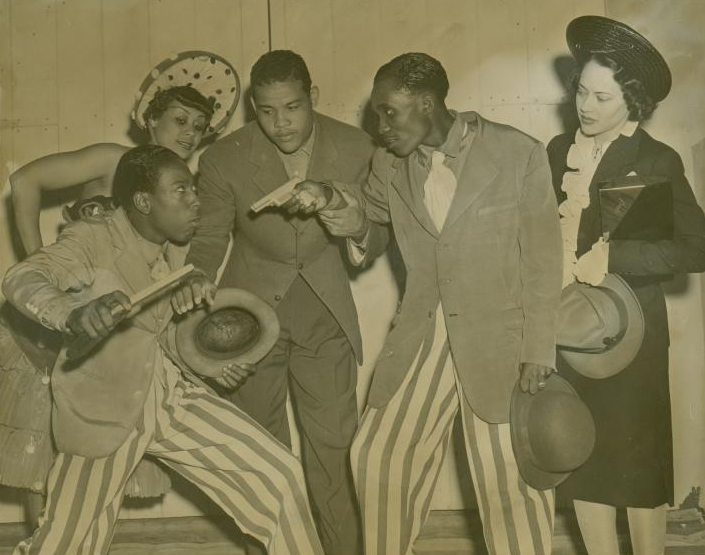
Champion boxer Joe Lewis, Fredi Washington, and others in a skit in the ‘Gay New Orleans Village’ in the Amusement Zone.



Black celebrity Bill ‘Bojangles’ Robinson (2) performs in costume, with telescope; Robinson christening the Temple of Jitterbugs. (below) Robinson with members of the National Association of Colored Women.
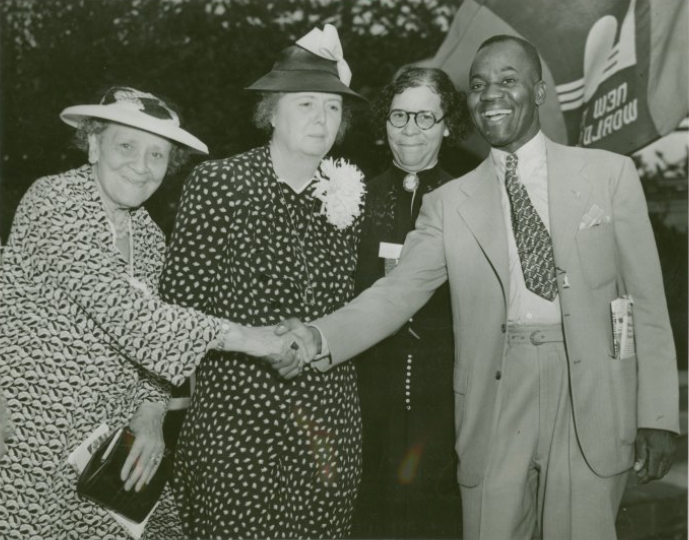
In the 1930s (and before) the study of Eugenics (3) was actively pursued by many who sought to prove a scientific basis for the superiority of a white, Nordic race. An exhibit analyzing race was organized by Dr. Gerald Wendt,(4) the Fair’s director of science and education. (Wendt, 1950s author of The Prospects of Nuclear Power and Technology, You and the Atom, and Atomic Energy and the Hydrogen Bomb, later headed the publication center at UNESCO. During WWII Dr. Wendt served as a captain in the Chemical Warfare Division and aided in the development by the United States military and chemical experts of several new toxic gases and the gas mask.)
Professor Franz Boas,(5) exhibit collaborator and national chairman of The American Committee for Democracy and Intellectual Freedom,(6) writes, “Ignorance, prejudice and unwillingess to examine uncongenial facts are elements that endanger the wellbeing of a republic which is governed by the will of the people. [The Committee} considers it one of its main tasks to lay bare the sources of prejudice...”
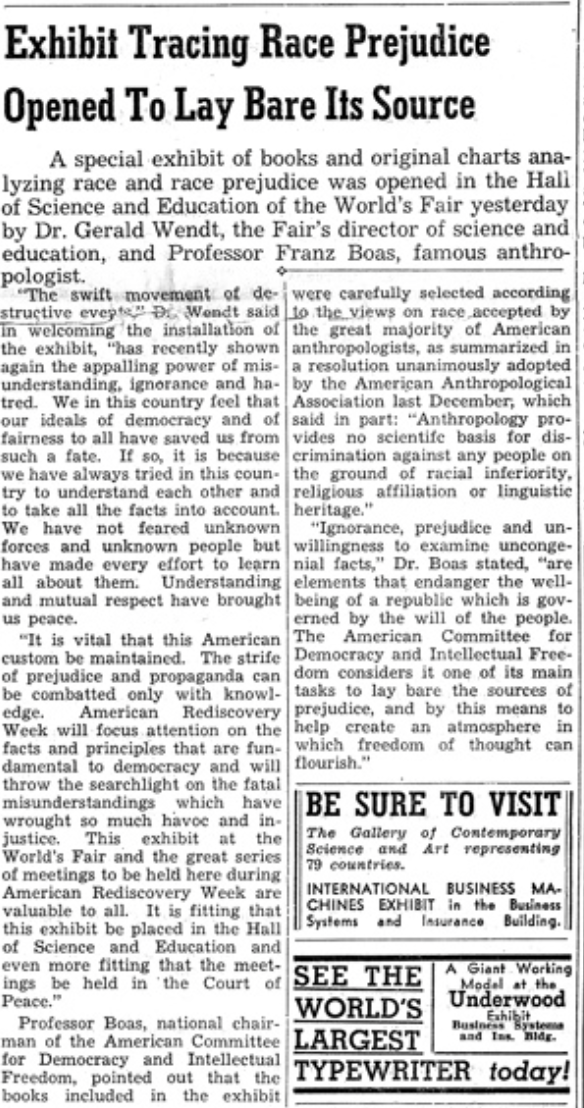
Boas (a German immigrant known as the founding father of anthropology in the United States) worked to refute the premises of Eugenics:
Anthropology is the investigation of human being. Franz Boas’ dream was of a big anthropology that studied the ‘whole’ of this being, which included the interconnection of the cultural and the biological in all places and all times. Sadly Boas never attained his dream because it was so necessary at the beginning of the 20th century to demonstrate that one biological-cultural connection did not exist, that between race and culture. (Stephen Reyna, “Boas’s Dream and the Emergence of Neuroanthropology,” Anthropology News)
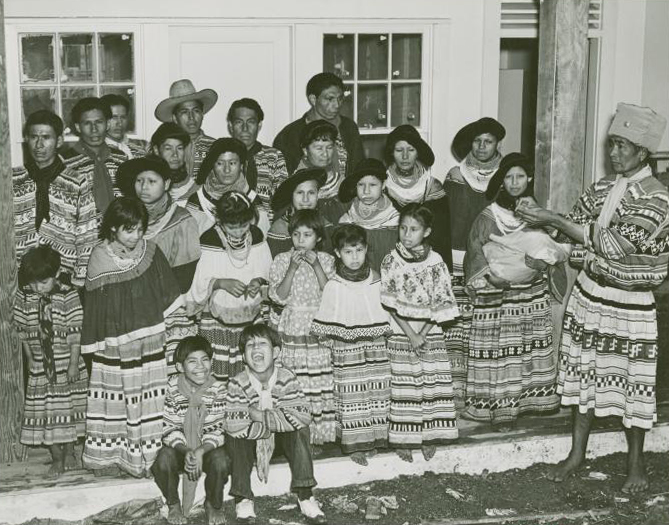
Elsewhere in the Amusement Zone, a resident village of Seminole Indians (7) was created—just one more of the sites of the 1930s exhibition shows organized and toured around the country, puportedly to share cultural life and customs of indigenous people:
The same group that put on the Canadian and Chicago shows organized the 1939 New York World’s Fair. It was the longest exhibition by far; a painful seven months. This exhibition show seems to have been the most difficult, not only for the length, but also the climate. New York was cold. Heaters were installed to battle the low temperatures. Coconut trees and crocodiles perished, although the alligators resiliently survived. Fifty Seminoles attended this long exhibition, which began on April 18, 1939. Like the previous shows, it included a full-scale Seminole Village, tropical plants and animals, sewing and cooking demonstrations, and alligator wrestling. The 1939 New York World’s Fair marks the end of the peak for Seminole people at exhibition shows, but not Seminole involvement in tourism.

‘Native costume’ and crafts in the Amusement Zone’s (8) Seminole Village. Films of the time reveal the poorly constructed amusement features as tawdry sideshows. False and sensational representions of the lives and customs of native cultures were mixed among attractions of nude burlesque and other carnival acts.
(below) Today at the Fair, Thurs August 17, 1939. Amidst minor sideshow articles, ‘Seminole Indians On Death Fast’ reports on the mysterious death ‘of a squaw’ within the Amusement Zone‘s Seminole Village.
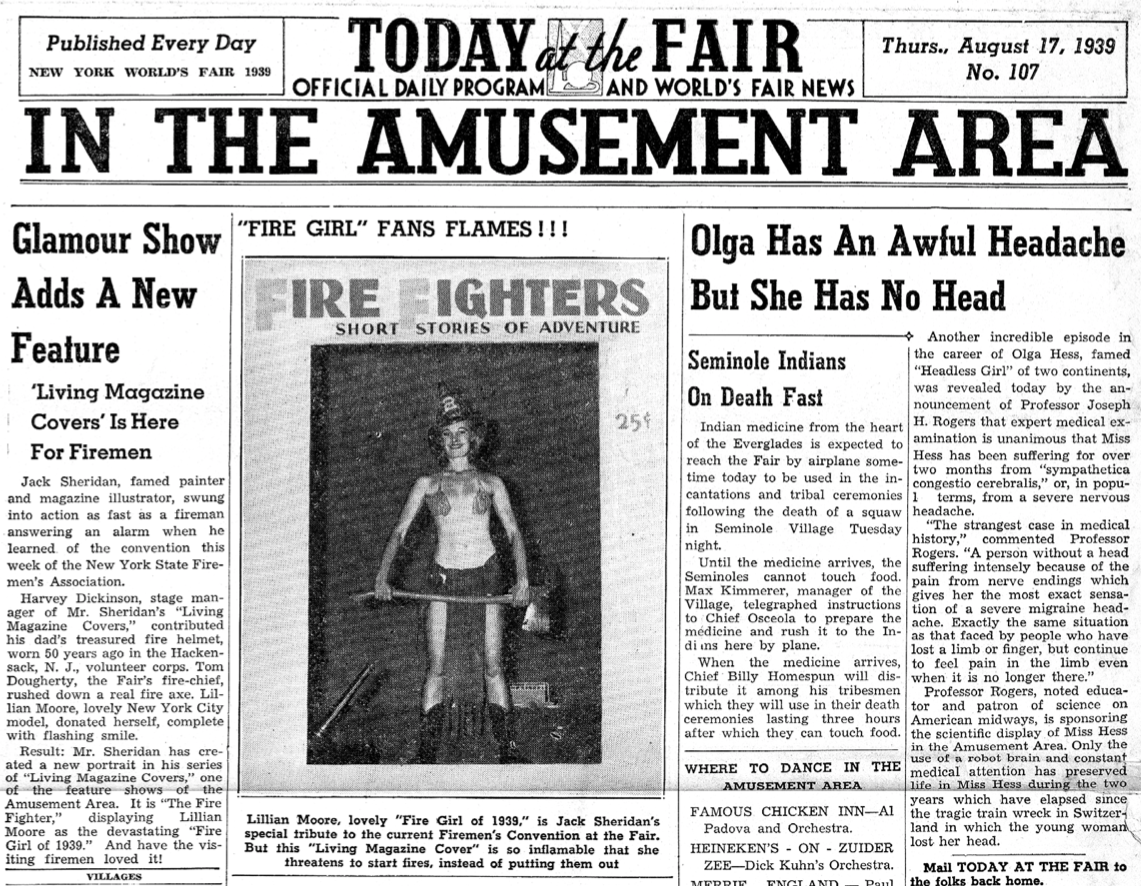
Racism persists as America’s ‘original sin’ and continues to vex almost every aspect of our democracy, with the current administration embracing xenophobic policies for handling voting,(9) policing, and immigration.(10) It’s impossible to keep up with every news story detailing racial violence and discrimination, both here and abroad,(11) with massive migrations due to climate events and genocidal regimes testing every nation’s borders and policies. The xenophobia of 2019 parallels the rise of fascism across the globe in 1939; the current threat to democracy is being played out in far-right movements around the world, with each election a dramatic struggle between authoritarian and democratic rule.
Notes/links: (1) The Negro Motorist Green Book, Library of Congress; (2) legendary dancer Bill Bojangles Robinson (in The Sand Dance from the film Stormy Weather), YouTube; (3) The Nazi Connection: Eugenics, American Racism, and German National Socialism, Stephan Kuhl, Oxford University Press; (4) Science and the New York World’s Fair, (JStor) Scientific Monthly; (5) Professor Franz Boas: German American Anthropologist, Brittanica; (6) Scientists Establish the American Committee for Democracy and Intellectual Freedom, DeGruyter (also: American Committee for Democracy and Intellectual Freedom, 1939–42, Yale University Archives); (7) The 1930s: Age of Exhibition Shows, Florida Seminole Tourism; (8) Home Movies/The Medicus Collection: New York World’s Fair Collection [reel 6: the Amusement Area], YouTube; (9) Supreme Court Makes it Harder for Tribal North Dakotans to Vote, Pema Levy, Mother Jones; (10) More Cities and States Should Divest from Private Prisons, Scott M. Stringer and Javier H. Valdés, NYT; (11) ‘They Spit When I Walked in the Street:’ The new Anti-Semitism in France, Adam Nossiter, NYT